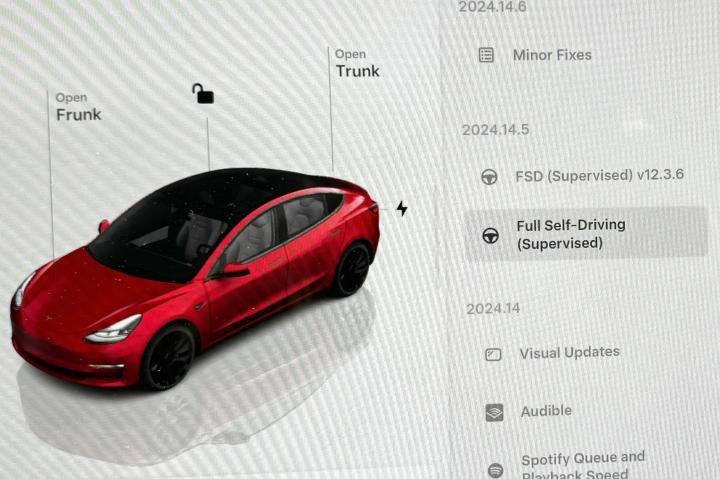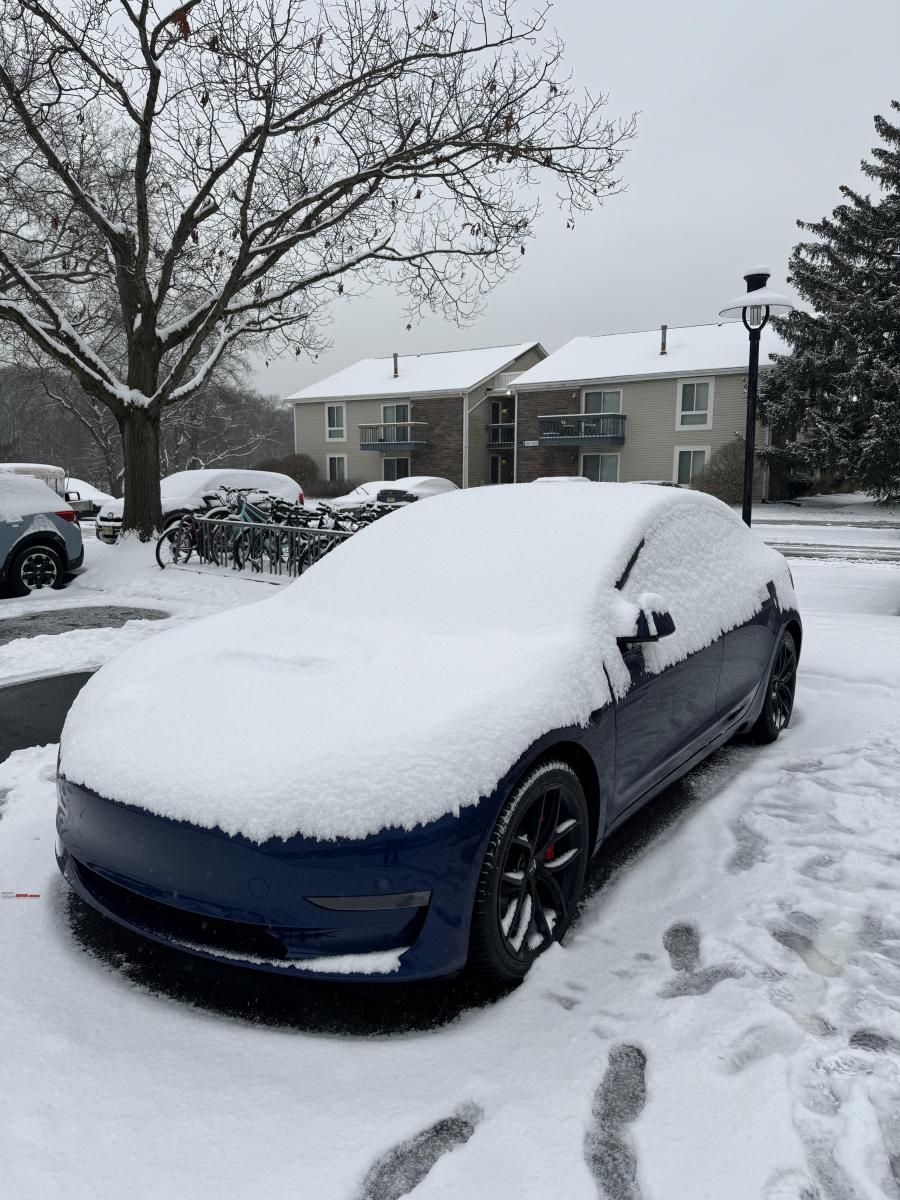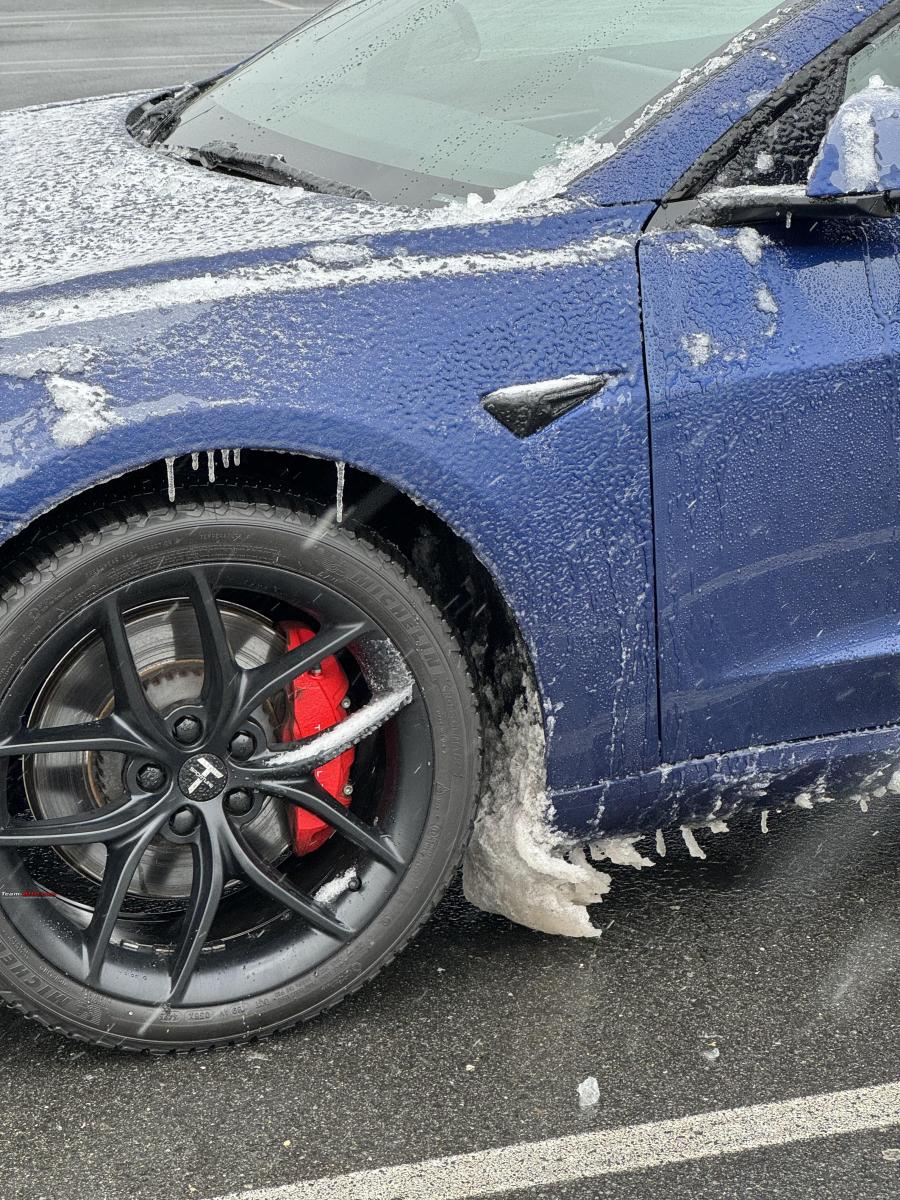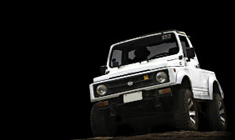News
The Growing Global Domination of Chinese EV Makers
Chinese auto makers are putting in an extremely level of automation in their factories. It also involves some breakthrough innovation in production scheduling practises.
BHPian 84.monsoon recently shared this with other enthusiasts.
China's booming EV Market
One of the most remarkable developments in the global electric vehicle (EV) market in recent years has been the phenomenal growth of the Chinese EV industry. China produces almost 70% of all new EVs made in the world in 2023. EVs made up 31% China car market and 37% of Chinese car production in 2023, when accounting for exports. More than 100 new EV models were launched in China in just the last year! China is now the largest exporter of automobiles in the world, having just overtaken Japan by exporting 4.91 millions cars in 2023. This is more than the entire annual production of all passenger cars in India) and EVs make up more than 40% of China passenger car exports.

BYD recently sounded the death knell for its western competitors by launching the Seagull pure electric hatchback at a price of $9668. This has shocked the entire global EV industry, especially the big players in the US including Tesla and the big three Detroit Best auto makers. Chinese EV have become a burning topic in the campaigning for the upcoming US presidential election. With Donald Trump crying that there will be a bloodbath due to import of Chinese EVs if he does not win. The US commerce secretary recently said that letting millions of Chinese EV ply on American roads would give China the ability to shut down the US, by remotely turning off all the EV simultaneously. In February, Tesla CEO Elon Musk warned investors in an earnings call that Chinese EV firms will "demolish" their Western rivals if trade barriers aren't put in place to limit their expansion.
A highly Supportive Business Environment
The Chinese EV industry has benefited immensely from highly supportive government policies, free availability of capital, large domestic demand, and admittedly, strong innovation capabilities. Besides state-owned players like SAIC, the local provincial governments in China’s 20+ provinces (who compete to create champions in various industries from their respective states), often inject billions of dollars of capital into local players in the guise of buying company share stakes at unrealistically high valuations. Government handouts for electric and hybrid vehicles were estimated to add up to $57bn between 2016 and 2022. This means, many EV companies get richly funded, even if they lack the wherewithal to compete with the best of the players across the country, which results in fragmentation - there are over a 100 EV players in China currently!
Average profit margins of the Chinese industry are as low as 5%! This makes it a very hard business case for private enterprises to garner the necessary investments and therefore, the industry is highly dependent on national and provincial government incentive support to grow. The current strategy of the governments in China seems to be to let a 1000 flowers try to bloom – then pick and choose the ones that actually sustain. There seems to be a shift and approach recently with recognition that consolidation of the industry players is required to attain global scale and access.
As the below chart shows five of the top ten companies that received the maximum government subsidies in China in the first half of 2023, were domestic Chinese EV companies.

Europe Calling
European auto makers stand lose the most from the Chinese onslaught. The import duties levied on Chinese EVs s are not very high in Europe and these vehicles are already flying in most countries. European consumers love them, as the EVs made in the EU are so expensive that many consumers cannot afford them. Imported Chinese EVs offer an attractive alternatives as they match many of the domestically produced EVs feature for feature and powertrain for powertrain, and yet cost 40-50% less the locally produced comparable cars. Chinese firms have been consistently buying up European automakers in the last several years. For example, Geely, a big Chinese carmaker, owns several European brands, including Volvo, Lotus and Polestar (an EV-only spin-off from Volvo).
The Euro block is not able to take a stern stance on Chinese EV imports or impose penal duties, as Europe and China are each other’s largest trading partner, with China supplying 20% of all imports across commodities into the EU and accounting for 10% of all EU exports. Retaliatory action by the Chinese to any duties imposed on their EVs by Europe could harm Europe severely, specially at current time where the economy is quite turbulent with the wars going on in your backyard.
Chinese car makers are actively working on setting up local manufacturing in Europe, North America and South America, to partly counter the threat of higher import duties for cars shipped from China. For example, the US has a free trade agreement with Mexico, and multiple Chinese companies are aiming to set up local manufacturing there to benefit from this FTA. However, it does not take long for the destination country to figure out clever barriers to isolate and slow down Chinese carmakers trying to make use of this route. Countries such as UK are trying to exclude the Chinese companies assembling EVs in EU from enjoying these lower tariffs, by stipulating that a majority of the core components and value addition in making the EV needs to come from the EU to enjoy the lower import duty.

The Inflection Point
The rapid rise of EV In China can be traced back to a sharp policy shift made by the Chinese government after Beijing and Shanghai became infamous for being the most polluted cities in the world in the middle of the last decade. In early December 2015, Beijing city had to be shut down due to severe air pollution. In 2017, the Chinese government allowed Tesla to make cars in China without a local partner. Tesla then opened a factory in Shanghai in 2019. This was part of a concerted effort to promote the adoption of EVs. Since then, the market has grown at an astonishing pace and it is estimated that 80-90% of all cars sold in China by 2030, will be either EVs or strong hybrids.
In Q4 2023, BYD overtook Tesla to become the world’s largest pure EV passenger vehicle maker by volume. Its rise has been meteoric. As the chart below illustrates, while Tesla’s global volumes grew by approximately 140% in the last 3 years, BYD’s volumes grew by 1000% in the same time. BYD has been mainly targeting gasoline engine cars to gain market shares, with its “Electric cheaper than Gas” slogan.

To tackle slowing EV demand in China, BYD has relied on a series of price cuts. Recently, Reuters reported that Tesla may have cancelled the long-promised inexpensive car (Model 2) that investors have been counting on to drive its growth into a mass-market automaker. Target pricing for this vehicle was pegged at $25,000, however the launch of similar electric cars by BYD at $10,000 price point has gutted these plans. This signifies a major shift in the company’s vision – In 2006, Elon Musk declared that Tesla’s mission would be to eventually make available affordable EVs for the mass market once it made enough profit from its premium vehicles.
Trade Barriers
Recently, Elon Musk said that Chinese EV firms will demolish most other companies around the world, unless trade barriers are established. There is intense lobbying happening in many countries to erect stiff trade barriers against Chinese EV imports. The European Commission launched an investigation late last year, into whether to impose punitive tariffs to protect European Union producers against cheaper Chinese electric vehicle (EV) imports, it says are benefiting from state subsidies. Chinese industry bodies object vehemently, calling this n one-sided probe stacked against the interests of the Chinese manufacturers.

In the future, one can expect there are majority of countries which have a domestic EV industry they are trying to develop, will impose some form of tariff or non-tariff barriers against Chinese EV imports. India is a stark example, with very high tariff barriers on imported automobiles, including EVs. It recently introduced a scheme where global EV manufacturers willing to commit significant investments into local production will enjoy lower import duties for a limited period of time on their more expensive models. This is a delicate balancing act between protecting local EV industry which aims to cater to the lower to mid end of the domestic EV market, versus imports that would address the top end of the EV market.
Car Company? Or Tech Company?
There is a marked difference in the vision and strategy of Chinese EV companies compared to auto makers in the rest of the world. Many young Chinese EV companies consider themselves to be tech companies who also happen to make EVs. Earlier this week, Xiaomi introduced its brand-new EV – the SU7 (Speed Ultra 7). Xiaomi aims to use is extensive experience in electronics and home appliances to make superior electric vehicles and become a top five maker globally in five years. The SU7 takes aim directly at Tesla Model S and the Porsche Tycan – only, it is being sold for a quarter to third of the price of these competitors! Huawei, a telecoms firm, and Baidu, a search engine, have also teamed up with car firms to make vehicles.
One of the reasons to fear the Chinese EV makers is that they are able to pull off much shorter product life cycles effectively. The average lifespan of one generation of a car model in the western world (which are used to making ICE cars) is about seven years. For instance, the Q8 etron was introduced in 2018 and continues to sell with various tweaks and facelifts even today after six years. This cycle provides the automaker with many years of development time and testing time to prepare the next generation model. On the other hand, Chinese carmaker are introducing EV and refreshing them at a rapid rate with much shorter life cycles. This is a completely different clock speed than what European and American car companies are used to. Even Tesla, which is considered a highly agile company, has been selling the same Model 3 since 2017, with only one facelift in between that was introduced in 2023.
Manufacturing Process Innovation
Chinese auto makers are putting in an extremely level of automation in their factories. It also involves some breakthrough innovation in production scheduling practises. Traditional car production lines, pioneered by Ford, follow a continuous flow, moving to the next step immediately after completing a task. In ideal conditions, this method streamlines the process and reduces production time, and is the standard practice in large-scale industrial manufacturing. However, car production has become more complex, and a purely linear model isn’t always the most efficient for all stages of production. Therefore, this model is continually evolving in its application. NIO’s new factory has multi multilevel parking structures by semi-finished cars are stacked.
The vertical car garage functions as an intermediate station bridging two production processes. It temporarily holds vehicles or semi-assembled car bodies, organizing and combining them as needed to align with the requirements of various workshops or processes for batch operations.
For example, in the painting shop, the paint pipelines are designed to accommodate various colours, but changing colours typically involves completely emptying the pipeline, adding new paint, inspecting, and changing the spray gun. The common industry practice is to change paint after painting around three or four cars. In contrast, stacking cars in the intermediate vertical garage prior to the paint shop and re-organizing the subsequent flow sequence on the production line based on paint colours, can enable up to 20 cars to be painted simultaneously. This reduces production costs, reduced paint waste, increases efficiency, and stabilizes the production process by lowering the number of colour changes required.

This is in contrast to the textbook Toyota Production System, thought to be the mast efficient in the world and adopted by so many global manufacturers, which requires that changeover be very rapid. In this system, vehicles would arrive in a linear sequence and the station would change over its operation ever more rapidly, through continuously analysing and improving the changeover process, so that a “production volume of one” can be achieved. This model assumes that the sequence of arrival of the chassis on the line cannot be altered. The new production model turns the assumption on the head, whereby those operations with inherently longer change over times are not actually interrupted for changeover, instead, the sequence of arrival of the incoming chassis is altered, to reduce the number of changeover required. With advanced robotics and vertical stacking technologies, this type of alternative production philosophy to achieve efficiency and speed of production and reduce cost is perhaps the way to go in the future.
Another example is on production lines where different body shapes can be assembled for the same underlying platform. Although most modern car manufacturers pride in the fact that their platforms are highly flexible and multiple body types can be built on the same production line in a sequence of just one unit at a time, this is not exactly the most efficient from an assembly operation perspective. It is more efficient to have groups, of cars belonging to the same body type arriving in sequence, before switching over to another body type, as it is easier and faster on the assembly operation itself. Intermediate vertical stacking and sequence re-shuffling can make this possible
Another innovation is that adjacent to the production line in the final assembly workshop, Nio has set up dedicated work areas for assembling components like tailgates, dashboards, windshields, and panoramic sunroofs. The vehicle body is transported to and from these work areas using automated guided vehicles. While traditional lean production methods utilize the same machine to assemble a set of component parts, Nio’s approach employs robots to autonomously assemble them on separate “islands.” Structuring certain operations in this manner can boost production efficiency and flexibility. By isolating “islands” from the assembly line, the method is also able to minimize the impact issues in any single island process from affecting the overall production pace.
This approach is highly adaptable to changes in different components, easier to implement, and less disruptive to the primary assembly line’s tempo. According to Nio, upgrading a production line to incorporate non-major changes, such as adding a feature to their ET5 model, would only take about two weeks at the Nio factory, whereas other companies might require up to six weeks. This creates competitive advantage in faster pace market for newer variance and introduction of new features.
What Next?
The Chinese EV industry is not content with dominating its domestic market, but has ambitious plans to dominate the industry globally. They are disrupting the established pricing models of manufacturers such as Tesla, BMW, and Mercedes. The recent sharp drop in Tesla share price and the internal announcement of the company abandoning their low cost, entry-level EV, are a clear hint that their strategy is succeeding.

Chinese players are forming partnerships and alliances with local automakers, suppliers, and distributors in overseas markets (example - CATL's joint venture with Honda, and BYD’s battery sourcing agreement with Mahindra). They are leveraging their cost advantages, technological innovation, and diverse product offerings to appeal to vastly different customer segments.
Chinese EV manufactures are opening their purses wide, and can well afford to do so, given the plentiful access to cheap money. They are investing, not only in Research and Development, but also in branding and marketing - to enhance their reputation and credibility among international consumers, regulators, and media, A good example of BYD's sponsorship of the COP26 climate summit.
These companies are also re-inventing manufacturing and supply chain processes. They have come to the realisation that the First Age of auto manufacturing using classical assembly line techniques, initiated by Ford over hundred years ago, nor the second Age, based on Just In Time, invented by Toyota 50 years ago, will fit the EV age. The future of automobile manufacturing will be dominated by Advanced Personalisation, Shrinking Product Life Cycles, driven by massively cheaper robotic capability and rapidly changing manufacturing process technologies. I fully expect Chinese EV makers to invent the next Age of auto manufacturing, throwing out outdated practices and bringing in the full power of robotics and automation.

Strategies that Indian EV makers can adopt to counter the coming Chinese competition
Close home, the BYD Seal has been challenging the BMW i4 for a few months now and sitting the Indian market at half the price of the i4 but includes a significantly higher powered variants as well. Competition is coming hard and fast in every segment. The recent reduction in prices of the MG ZS EV is creating a dent in the sales of mid-size SUVs powered by ICE and Hybrid engines. below are some strategies that Indian manufacturers could think of to counter the abominable competition that is coming to our shores very fast.
1. Become an EV leader for the world’s developing markets:
Developing markets like India have peculiarities that the more developed countries such as China, the USA and Brazil may not have. These include very rough roads, erratic power supply, hot and dusty weather conditions, exposure to water during floods, etc. the Indian EV manufacturers have an opportunity to develop not only domesticity but also be able to export to other markets with similar characteristics. For this strategy to work, Indian EV manufacturers have to be very agile in their learning curve, being able to capture detailed data from their flat, already on the roads relating to failure, modes, service, case, histories, etc.
2. Emphasis on low cost serviceability
The Indian market is one of the most value extending markets in the world. Products are not easily thrown away or scrapped, rather their handed down across multiple buyers and used to the last economic possible point of the useful life driving around in the streets of India you can still see Maruti 800s from the early 90s, the Toyota Qualis and first generation Honda Citys from the late 90s, and the first generation Innovas from 2005 onwards in plenty. Many civil similar export markets are likely to be putting equal emphasis on the ability to extend the life-cycle of the car and have it serviced at a reasonably low cost point. Neither the luxury EV manufacturers nor the volume manufacturers from China put much emphasis on the suspect. For luxury manufacturers, a battery replacement is not a significant cost as a percentage of the vehicle cost and most owners may not mind such a replacement a few years after purchasing the EV. In the case of Chinese mass market players where speed and volume are more than focus. There is less management, attention and service and life-cycle cost.
3. Globalize by Expanding presence and reach in other emerging markets
where the demand for EVs is growing rapidly and the competition from the Chinese EVs is less intense. Indian EV makers can leverage their existing networks, reputation, and cultural affinity to establish strong footholds in these markets.
4. Advocate for favourable government policies and regulations
Policies and regulations need to support the growth and development of the Indian EV industry, such as subsidies, tax incentives, infrastructure development, and standards harmonization. Indian EV makers can also engage with the government, industry bodies, and civil society to raise awareness and promote the adoption of EVs in the country.
Sources:
- Global Electric Car Sales Trends – International Energy Agency’s “Global EV Outlook 2023” report
- Chinese Car Makers dominate top subsidy Recipients: Nikkei Asia
- New Car Registrations in Europe Data: Autocar Professional March 2024
- BYD Surpasses Tesla: Statista 2024
- Shorter Chinese EV product Life Cycles: Wall Street Journal
- About Xiomi SU7 : Mint
- Manufacturing Innovation at NIO
Check out BHPian comments for more insights and information.
- Tags:
- Indian
- Electric Vehicles
- China
- BYD
- Tesla
News
Trying Full Self-Driving feature worth US$ 12,000 on my Tesla Model 3
It has been offered to me as a 30-day complimentary trial that came along with a lovely software update.
BHPian mobike008 recently shared this with other enthusiasts.
Full Self-Driving (FSD) 30-Day Complimentary Trial
When I woke up a couple of days ago, Elon Musk dropped a nice surprise to perk up the weekend.
Got a message that I have been granted a Full Self-Driving (FSD) trial complimentary for 30 days.
It is available to purchase for $12,000 or $199 ++ /Month. Well, that's a lot of money for this feature which according to me should have been given either at a much cheaper price or bundled in for the expensive variant (like mine) as part of the whole package.
I will thoroughly test the FSD for the next 30 days and see if it's really worth the 12 grand.
What FSD can do more than Autopilot is automated city driving that includes:
- Stop and go at traffic lights and signs
- Navigation on roads without center lines
- Navigation of traffic circles
- Handles 4-way stops
- Makes turns, following traffic rules and yields to other cars and pedestrians
Since we have plenty of roundabouts here, I already tested #3 and #4 and it blew me away.
Will post some videos once the testing is completed.
This came along with a lovely software update and primarily the visual update now shows all features full screen on this large beautiful screen.
Lot of other useful features as per screenshots below (Features are all self-explanatory).
Excited to fully use all features and see what is this "FSD Brouhaha" all about.
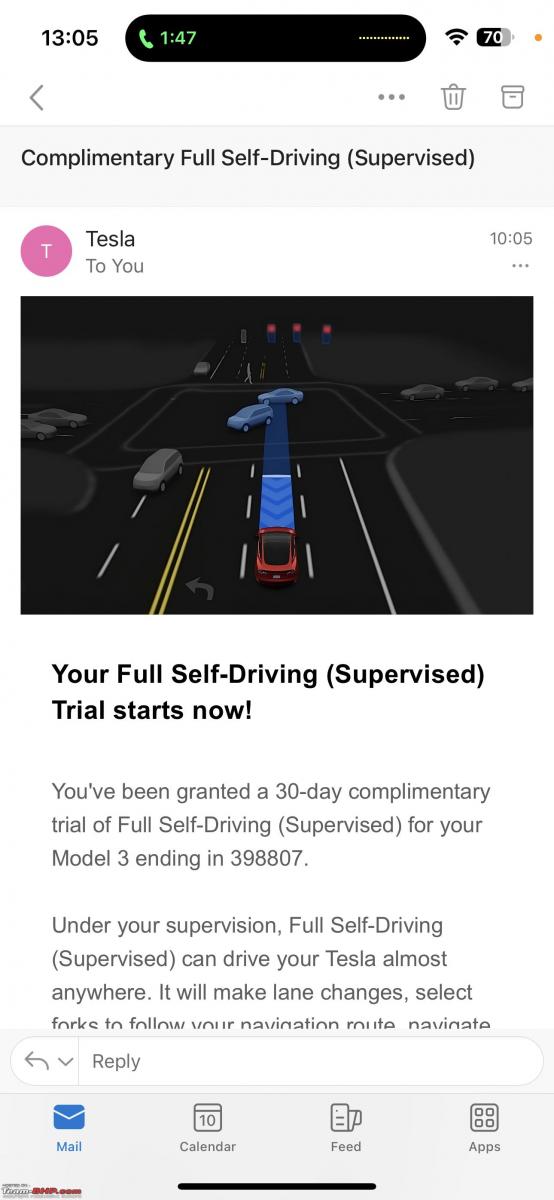
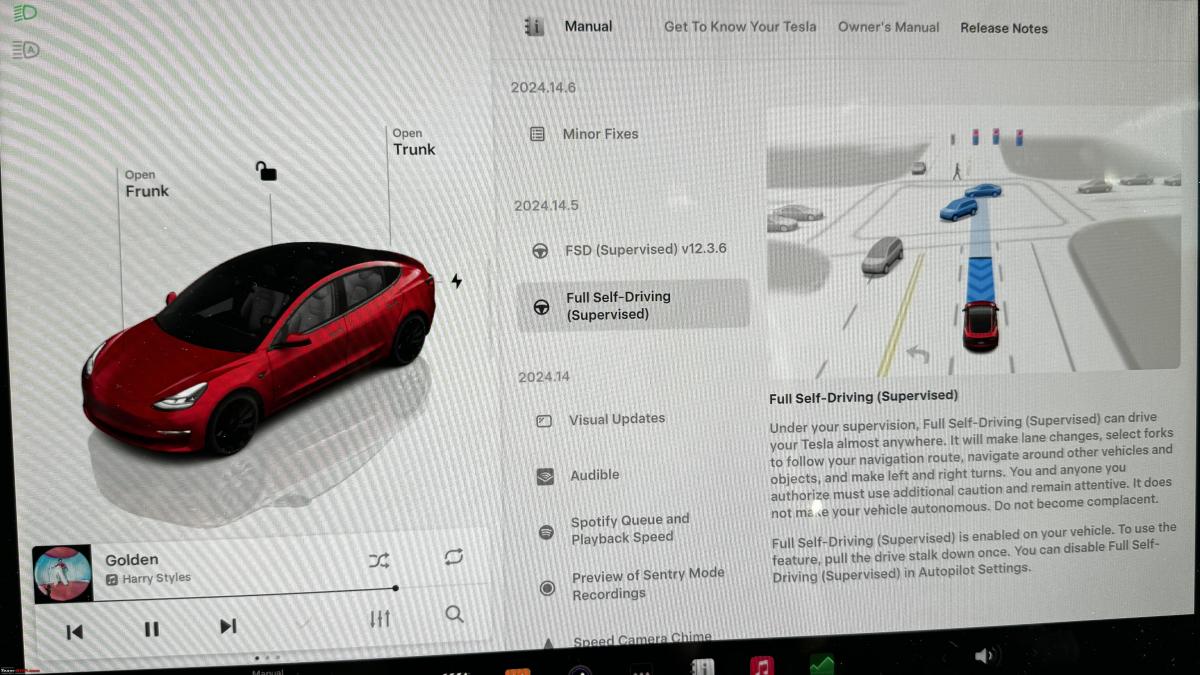








Check out BHPian comments for more insights and information.
News
Tesla files lawsuit against Indian battery company Tesla Power
Tesla Inc. had started receiving complaints from customers which were actually meant for Tesla Power.
According to media reports, American EV giant Tesla has filed a lawsuit against an Indian battery company named 'Tesla Power', alleging trademark infringement.
The EV maker is already said to have sent a cease-and-desist letter to the Indian company in 2022, which has a global office in Delaware, under the name 'Tesla Power USA'.*However, the company continues to use the name even now and argues that it manufactures "lead acid batteries" and not electric vehicle batteries and that it has no aspirations of entering the EV industry.
Tesla Inc., however, states that the use of the name by the Indian company is causing confusion in the country. The EV maker's senior counsel, Chander Lall, stated that Tesla Inc. had started receiving complaints from customers which were actually meant for Tesla Power.
The judge has barred Tesla Power from releasing any promotional material with the "Tesla" name until its next hearing scheduled for May 22. The battery company will also have to give a written response for its defence by then.
Source: FoxBusiness
- Tags:
- Indian
- Tesla
- lawsuit
- International
News
Amazed by Tesla's useful tech integration in its EVs & customer service
I cannot even begin to describe the WOW factor I have as a car owner or petrolhead to imagine this kind of 'useful' integration of tech and cars.
BHPian svsantosh recently shared this with other enthusiasts.
A senior colleague in my UAE office has a 2023 Tesla Model Y. He has owned it new from the Dubai Sheikh Zayed road showroom for the last 6 months and put in about 10,000 Kms on it. A very happy customer indeed.
Last week he got a call on his mobile and the person on the line identified himself as a Tesla Roadside Assistance mobile mechanic and said 'Sir your rear right tail lamp is not working and I need to come to your location now to change it'.
Obviously, we are not used to such kinds of calls and my colleague went blank for a few seconds. He agreed to receive him in the next 30 mins and the person arrived in his fully decked-out service van. In 15 mins he changed the full assembly and off we went.
Now...
See the level of tech integration Musk has pulled off with a few satellites and the internet. Sitting at a laptop in the A.S.S, a mechanic saw a tail lamp failing on his customer's car and came in an hour and gone! I cannot even begin to describe the WOW factor I have as a car owner or petrolhead to imagine this kind of 'useful' integration of tech and cars.
Between 2016 and 2022, I was associated with IOT & M2M projects in the conventional mechanical engineering industry, linking large turbines to one's mobile phone and giving real-time data on Pressure, Power, RPM, Kw, Temperature, Oil life, etc.
Now I am seeing that kind of tech coming full circle. Now that's called Customer-Centric Service. Kudos to Tesla!
Here's what GTO had to say about the matter:
Great story, thanks for sharing. That is really exemplary service. Not just the call to fix the light (a safety issue), but also the offer to come to the customer's home / office to fix it.
For everyone who is excessively worried about privacy, drive this (or any older non-connected car):

Use this phone:

And don't ever connect to the internet, or use Google services, or social media, or online shopping:
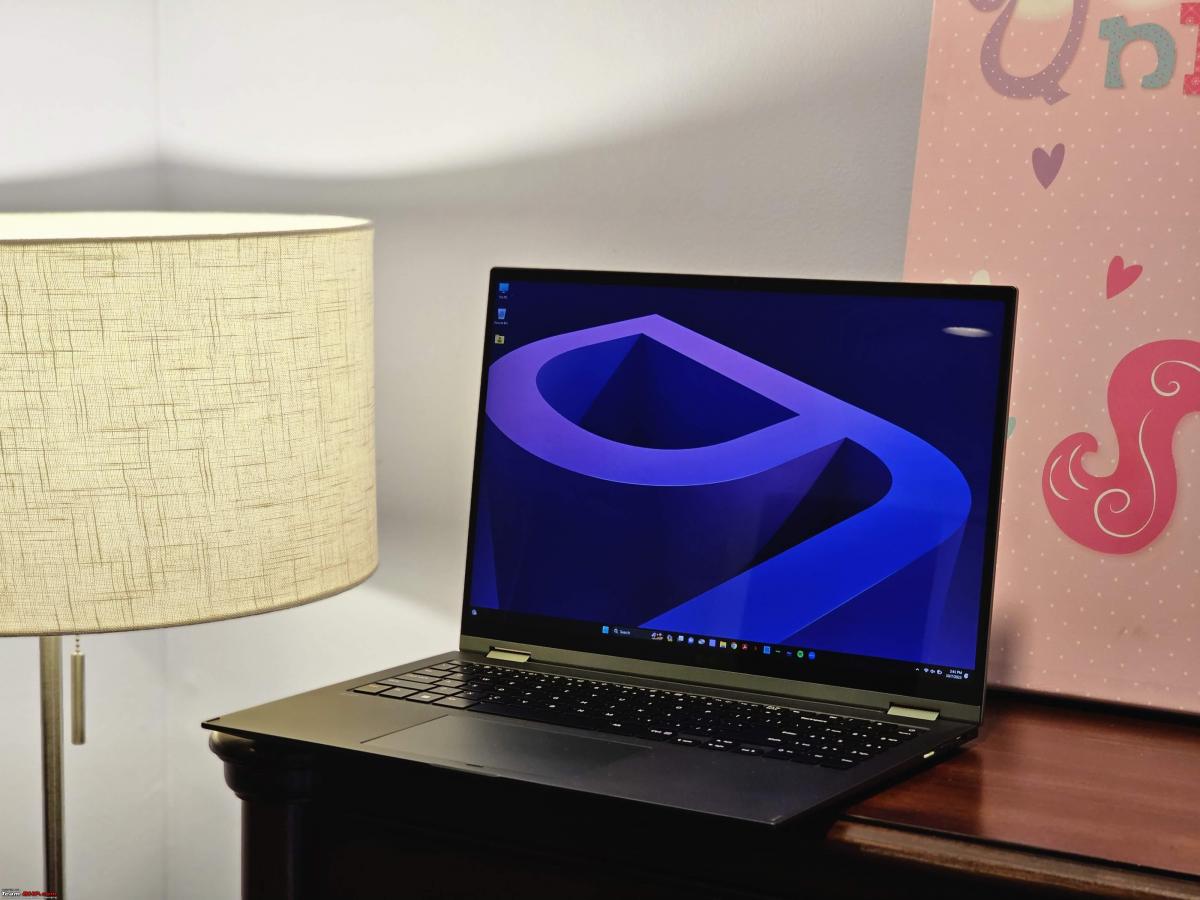
Truth is, privacy is a myth today.
Here's what BHPian Night Raven had to say about the matter:
Somehow I am more horrified than excited about this. If this happens to me I will be uneasy every time I sit in that car because I don’t know what all information the technicians at the service centre can access about my car. If my location can be continuously monitored by some stranger, how safe should I feel?
Here's what BHPian Fuldagap had to say about the matter:
It's exciting to read this experience. But I'm curious to know how a mechanic 'saw' the taillight is not working. Did the car 'inform' the service guys?
Did the owner get a notification too via any app or email that his taillight wasn't working prior to receiving a call from the service personnel?
One day a car will 'calculate' it is idle for hours, the owner sleeping at home or working at the office and would say to the owner, hey my tail light isn't working, I'm off to get it done by the time you need me. I'll be back in a couple of hours.
Here's what BHPian poloman had to say about the matter:
Some one other than you keeping track of your possessions is called creepy behavior. Nothing to get excited about. The fault should be flashed to the owner and he should take a call to fix it or not.
Check out BHPian comments for more insights and information.
News
Owner of Tesla Model 3 Performance & BMW X3 M40i compares his two cars
This EV handles “almost” like a sports car. On the other hand, I have driven larger BMW SUVs like the X5 and X7 and in my opinion, the X3 is a lot more enjoyable.
BHPian mobike008 recently shared this with other enthusiasts.
2023 Tesla Model 3 Performance vs. 2021 BMW X3M40i
Thanks to TorroRosso asking this question, “How does the Tesla Model 3 Performance fare compared to my BMW X3 M40i”. Well, it’s not the first time I got this question and surprisingly, I can never provide a straight answer to folks who ask me “Which one of these 2 performance cars is better" because it’s truly a very difficult answer as both are really fast cars and have many upsides with negligible downsides.
I decided to finally put a rest to this quandary and have been collecting my thoughts to see if I can nail down which of these 2 cars is better. I have owned both cars for a reasonably long time to tell the difference between each of them.
The final result may be surprising, keep reading and try to put yourself in my shoes and feel free to comment if you own any one (doubt if someone will have the exact same combo at home...haha!) of these amazing machines. Will your final result be different?
BMW X3M40i has clocked 34,000 miles (~ 55,000kms) in 3 years and Tesla Model 3 Performance is approaching 16,000 miles (~ 26,000kms) so that’s 80,000kms combined in 3 years with just me as the single driver (not counting the limited driving of my better half). This comparison is most certainly not an apples-to-apples type of comparison but, will have factors like emotional, tangible, placebo effect and not to mention the overall feel playing key roles.
Let’s look at the broad categories/parameters that we generally consider when selecting a car (All my car purchases till date have always focused on a single parameter for decision-making- “Performance” because I enjoy driving fast and love a good handling automobile. Other parameters are good to have but, they have never swayed my decision when buying any automobile).
Performance
Tesla Model 3 Performance
This is a drag strip king and will demolish everything that is stock that comes into its path- Be it a BMW M3/M4, Lamborghini or a Ferrari. Its instantaneous acceleration that propels you to 60mph (96kph) from a standstill in 3.1 seconds is an experience not for the faint-hearted. This acceleration is the #1 factor for purchasing this car. It’s simply an other-worldly experience.
BMW X3 M40i
This car is no slouch. A stock version does 60mph (96kph) in 4 seconds which is ridiculously fast as well. The feeling of how this accelerates is very different from the Tesla. It is loud, has lots of pops and bangs, rattles your internals and brings a thrill to your body that is felt till the bones. On the other hand, Tesla’s acceleration feel like you are sitting in an airplane and being propelled forward in complete silence which is quite eerie but, exhilarating at the same time.
Winner
Both have exhilarating acceleration but, giving it to Tesla Model 3 Performance purely for reasons of it being faster.
Handling
Tesla Model 3 Performance
Firstly, it’s a compact sedan and secondly, it’s lighter than the BMW so it has 2 primary factors favoring it. Obviously, it handles better than the BMW. Being a performance model, it has stiffer suspension, bigger brakes and can also be used as a RWD or AWD as the bias can be changed by flick of a switch (via. an internal computer). It’s easy to make this change when you want the tail to step out in corners.
In short, the Tesla Model 3 handles “almost” like a sports car. With a little bit of modifications to its suspension which I personally feel needs to be tauter (It isn’t even as taut as the X3M40i) and it can be compared with any Porsche in the handling department.
BMW X3 M40i
Well, it’s a BMW. It feels tight, crisp, and better than good handlers. It’s a Compact SUV, It’s heavier than the Tesla. Despite all these odds, It handles better than 90% of sedans out there. Having driven the larger SUVs in BMW stable like the X5 & X7, in my opinion, the X3 is nimble, changes direction pretty fast and being smaller it is a lot more enjoyable handling experience.
It certainly has some body roll (felt especially during the roundabouts near home) but, for 90% of regular road driving including tight cornering in mountains which I have been doing ever since I got this car, it feels absolutely marvelous. Its technology is highly reliable, and its AWD system never made the car miss a step even in horrible conditions (Snow Blizzards, Heavy Rains) in the mountains where I have never curtailed my speeds. In short, it can shame many sedans in the handling department.
Winner
Tesla Model 3 Performance as it’s definitely a better handler than the BMW.
Ride, Comfort & Braking
Tesla Model 3 Performance
Tesla has premium vegan seats (Optional) and they are big, soft, cushy and really comfortable. As I had mentioned before, it was designed with the big “American backside” in mind. It almost feels like sitting on a couch at home as they are that comfortable.
Ride on the 20” Uberturbine wheels is comfortable on “Tar” highways but, the moment the car traverses on cemented freeways, road joints, or patchy sections, the ride is not that cushy anymore and you can feel a bit of harshness creep in. However, it’s not really uncomfortable or harsh in any sense, especially on WA road infrastructure.
BMW X3 M40i
Leather Seats are BMW M spec leather which means it’s harder on touch and feel and also feels premium than the Tesla seats. Overall seat construction is on the harder side & the bucket-styled seats somewhat snug into your thighs (Including the hard pull of seat belts when you start from a standstill) so, it’s not as comfortable as the Tesla. Ride is better than Tesla being on 19” wheels and now with Michelins, it just glides over patchy roads. Washington state road infrastructure is excellent including in the mountains.
I was never impressed with Tesla’s braking power. Even though my Tesla has all round discs, bigger pads, bigger calipers etc. being a performance model. On the other hand, BMW brakes which are M-spec brakes are fabulous and have the correct bite and power. Its stopping power is phenomenal. It is a pleasure to use the BMW brakes compared to that on the Tesla.
Winner
BMW X3M40i as its ride and braking is better.
Safety Aids
Tesla Model 3 Performance
This car is loaded with safety aids. 12 different cameras, Blind Spot Monitoring, Auto Pilot, Auto Steering, Forward Collision Warning, Auto Braking, Sentry Mode and the shebang.
BMW X3 M40i
Mine is a full spec’d car (meaning with all options) with all safety aids. HUD, Heated Steering Wheel, Cooling Seats, Pedestrian Detection, Blind Spot Monitoring, DSC, ASC, Forward Collision Warning, Auto Braking.
Winner
Tesla Model 3 Performance for the sheer long list of technology & safety aids.
Technology
Tesla Model 3 Performance
Tesla is not a car but, a computer on wheels and is renowned in the industry for best all-round safety and technology features and has been rated as the “safest car” to drive in all important forums. I cannot list the entire list of technology features as it’s just too many. I just have to highlight that you can enjoy YouTube, Netflix, HULU etc. in the car with premium audio that makes you feel that you are not sitting in a car but, an IMAX theatre for it to win this category. Lol!
BMW X3 M40i
It has all the features that BMW has provided as options, so it’s pretty much loaded from a technology aspect. But it’s still no match for the technology features of a Tesla.
Winner
Tesla Model 3 Performance
Space & Comfort
Tesla Model 3 Performance
This may come as a surprise but, many times family and friends who rode in the car have mentioned to me that there is more space in Tesla than the BMW. Yes, it’s true. It’s an extremely spacious car and has good space at the back for 3 adults for leg and headroom.
BMW X3 M40i
This car also has decent space for leg and headroom both in front and back and is more than enough for 4 adults. In the back, it’s best enjoyed by 2-adults and fitting a 3rd adult would be a bit challenging and tight.
Winner
Tesla Model 3 Performance
Build Quality
Tesla Model 3 Performance
Tesla had quality issues in the beginning but, they have improved a lot over the years. Double paned window glass has been added to improve NVH, panel gaps have been reduced considerably, paint quality has improved, and overall quality levels have risen.
BMW X3 M40i
BMW build quality is several notches above the Tesla inside and out. Everything feels premium and it’s a clear “Winner” for this category.
Redlight Acceleration
Call me immature or childish. I have this habit of launching at every red light (whenever I am the first car at the red light). As soon as the lights turn green and I hear the chime, A simple dab to the accelerator on the Tesla, it just rockets forward and within a few seconds, I don’t see anybody in my RVM. I accelerate from 0-60mph (speed limit) and probably go up to 70mph. It’s absolutely eerie to see nobody behind me. Lol!
Same is the case of BMW, when I accelerate on the greenlight, the drama is much more, and the entertainment factor is several notches above as it’s loud as hell and B58 makes some ridiculously loud pops and bangs and it’s with some kind of childish pleasure I love seeing an empty Rear-View Mirror.
Winner
I would give this to BMW as it commands more respect than the Tesla on the road.
BMW Trivia
- Whenever I am in a fast lane, I always see the car in front of me give way (move into the slower lane) after they notice the quintessential “BMW Headlights” in their rearview mirror. This happens so often that I tell my wife by instinct that the car in front of us will move. We had a wager on this topic a few times and I won always. That’s the power of the “BMW” and I love it.
- I always park next to a BMW if I find one and I see that happens with me also so many times when I return to the parking lot, I see another BMW next to me.
- In the US, this is common. If I see another BMW on the road, he is either going fast, not giving indicators (Though, I personally follow all rules to the T) OR, wants to race you. This rather childish behavior is what the BMW brand has imbibed in the owners, and everyone seems to do it in some form or fashion. LOL!
Fuel Consumption
Tesla Model 3 Performance
Tesla has time and again proved that it can save 80% ++ of fuel consumption costs. That’s a pretty big claim…right? And it’s 100% true.
BMW X3 M40i
For a performance car, the fuel consumption of the X3M40i is applaudworthy as no other car with these performance specs can return a gas mileage as the X3M40i. The worst gas mileage I got was 19mpg and the best was 27mpg. But it’s safe to say that an average of 22mpg is what I get each tankful and it’s quite good for this performance beast.
Winner
Tesla Model 3 Performance
Maintenance Costs & Issues till Date
Tesla Model 3 Performance
Completed 15,000 miles and there has been no maintenance till date. No tire rotations, alignment or any kind of service done. I spent $0 till date.
BMW X3 M40i
Completed 34,000 miles and have got it serviced at BMW 4 times till date for regular stuff. Here as well, I have spent $0 till date. I recently changed the tires to Michelin Pilot Sport AS 4 costing $1200 for 4-tires which is the only money spent on maintenance till date.
Winner
For now, it’s a TIE!
Longevity (Life of the Car)
Tesla Model 3 Performance
Tesla claims that the original battery will easily last for 300,000-500,000 miles and/or, 1500 times charging or discharging. Well, I think this car can be passed down for at least one generation if not, two. A battery replacement for a Tesla Model 3 Performance will cost $14,000.
BMW X3 M40i
The biggest reason for failure for a gasoline car is the engine giving up and B58 has been proven time and again that it’s the most reliable engine coming out of the BMW stable ever. There are plenty of examples of X3M40i owners driving this car without any issues up to 180,000 miles (~ 300,000 kms). Stock power is 382HP but, it can handle modification up to 650 Horsepower without breaking sweat.
Winner
Tesla Model 3 Performance
Overall Thrill & Final Summary
This may come as a total surprise after seeing that the Tesla Model 3 Performance winning literally every category that I listed above. But, from an overall thrill, emotion and feel perspective, I enjoy driving the BMW X3M40i more than the Tesla Model 3 Performance and the primary reason for that is the relentless power, torque across every inch of the rev range, that amazing B58 exhaust note, the pleasure of using those paddle shifters to play with the rev range and finally, of course, the badge value which I feel is more prestigious than the Tesla.
B58 Exhaust (This is what makes you love this more than anything else in the world).
Driving the BMW X3 M40i for 50 miles in one of the craziest blizzards that I encountered in my life.
A useless feature from Tesla- But this makes you love it equally as much.
Well, I have several acceleration videos of both cars which I have always refrained from sharing on the forum so as not to break any rules.
Hope you enjoyed this "Apple-2-Oranges" comparison.
Check out BHPian comments for more insights and information.
News
Tesla Model 3 Performance: 15000 miles report with range, charging cost
The EV's autopilot works flawlessly and I haven't had a scary moment so far.
BHPian mobike008 recently shared this with other enthusiasts.
15,000 Miles Completed - Brief Report
Last weekend, I completed 15,000 miles/24,000 kms in 17 months of ownership. Well, as some of you know, I work mostly from home. So, the majority of these miles have been "pleasure" miles and I have enjoyed every moment of it. It’s been an absolutely flawless run of owning this beast of a performance electric car. Touchwood, not a single issue till date that is worth losing sleep over.
15,000 Miles completed.
Let’s go ahead and dive straight into the feedback and cover a few points on things that could have been better.
Performance
This is the sole reason that I enjoy this car so much. I have driven the regular Teslas (RWD and Long-Range) and they are good in performance but, are no match to the blistering fast Model 3 Performance which performs like a rocket launched out of a launch pad. Lol!
Handling
Tesla Model 3 Performance handles like a sports car. Period!
The steering wheel feels nicely weighted in Sports and due to the lower center of gravity and no engine, this car feels totally planted and moves like an eel. A satisfactory enthusiast's car for enjoying the high speeds, handling and thrills minus the gasoline combustion engine noises which for some is a big deal. But, mature people who know what this vehicle’s purpose is will accept its traits and enjoy it for the purpose it’s built.
My route to home (Don't miss the snow-capped mountains in the background)- There are 6-roundabouts that I cross each day. It's fun to throw the car in these roundabouts.
Every single day, I have to drive through 6 of these roundabouts and I throw the Tesla into these roundabouts at higher than required speeds just to test its handling. It just slithers in and out of the roundabout like a rockstar with negligible body roll.
Range
Well, I have been mostly using the Tesla for local city driving which is usually 50-60 miles roundtrips and other errands which is about 10-20 miles a day. I charge the Tesla once in 3-days and is always up to 80% and typically plug it back in when the battery drops to 20%.
With a 60% usable charge, I get around 150-170 miles which is good for 3-4 days of usage. Tesla claims the Model 3 Performance's range is 315 Miles. I have long ago given up hopes on that range and stick to a realistic figure of 250 miles (0%-100% battery charge) which is acceptable for my usage.
Long distance- I have done just 2 trips to Vancouver, Canada till date which isn’t a long distance in any sense. Need to plan a proper long-distance trip which means driving at least 600 miles one-way. Hopefully, sometime this year. Incidentally, travelling to Vancouver again on March 23 so it will get charged again in Vancouver.
Charging Time
I always charge at home which charges at speeds of 35 kWh (Compared to Tesla Super chargers which charge between 300 kWh- 500 kWh per hour). I normally start the charging (scheduled on phone) at 11:00pm and it charges from 20% to 80% battery in about 4 hours. When I get up in the morning, the car is fully juiced up to drive for the next 150 miles.
Charging Cost
I prefer charging during off-peak hours so the rate is $0.08 dollar per kWh.
Simple math: I spend ~ $5 for every 170 miles (275 kms) of driving which is insane cost savings.
Gas to EV Comparison : 90% savings on gas costs.
Trivia : I have used a supercharger only twice in my Tesla Ownership and both times during my trip to Vancouver. Otherwise, it’s always charged at home and is not subjected to the brutal tortures of DC supercharging.
Tires
Pirelli Summer Performance tires are like leech during summer and in rains. However, they become equally useless in snowy conditions. Tires have never been rotated, balanced nor aligned till date. There isn’t any uneven wear and tear so I am a happy puppy.
Touchwood- Zero punctures till date since I got out of the showroom.
Autopilot
Works flawlessly and never a scary moment. I experienced phantom braking just once in this entire period. Whenever we are going back home from a party, autopilot drives us safely back home.
Autopilot gets confused in a few scenarios:
- Roundabout (We have plenty of them near home)
- Peculiar lanes in some areas where the lane markers are intertwined.
Regenerative Braking
Driving with just one foot is a pleasure. I hardly use the brakes in the Tesla. In fact, I keep checking if I can stop without using a brake. 9/10 times, I am able to stop if I am in “Chill” mode.
In “Sports” mode, it’s difficult to stop the car even with full regen mode, it will not stop on time as the regen power is not enough to bring the car to a halt in time.
As an example- I step on the brake pedal, a total of 4-5 times in my one full charge of 150-170 miles. This means the brakes will last “forever”.
ICE
I covered the In-Car-Entertainment/Music System of Premium Audio in a Tesla. This has to be the best music system (at this price point) in any car be it EV or Gasoline. The audio and video experience in the Tesla is second to none.
Space
Tesla Model 3 is spacious inside and out. Due to no hump running in the back-seat, 3 tall adults can sit comfortably. The space in the boot is very good and with seats down, we have transported living room size carpets, pots, plants and other home goods with ease. The frunk (under the bonnet) is also spacious and most grocery shopping stuff can be easily accommodated here.
Tesla Annual Renewal
I pay $99 per year for Internet Connectivity each year. It’s totally worth it as this gives you access to all the goodies (Netflix, YouTube, Hulu, TikTok etc) which is important when you are waiting somewhere in the car.
Niggles/Things Could have been Better
- 17 months of Ownership- Tesla froze just once in the first 12 months. Last 5 months, it froze 4 times. What I mean by froze is the screen becomes frozen and it needs to be re-booted/re-started. Darn, just like our phones. Lol!. The reboot process is a 2-minute procedure so it’s a minor inconvenience. In my opinion, this freezing business is acceptable if it happens once or twice a year. Anytime more is not acceptable.
- Sometimes the doors won’t unlock when I approach the car and try to unlock it. I have to then fish out my phone and unlock it from the Tesla app on the phone. Same thing with the charge port. This happened a few times so again a minor niggle.
- Insurance costs- For some weird reason, the insurance costs for a Tesla are higher than a gas car. I pay about $1600/year just for insurance. Compared to about $1200/year for a gas car.
- Rattles & Squeaks- 15,000 miles up and there is no hint of any squeaks or rattles. Sometimes I hear some minor squeak from my driving seat position only when I move around in my seat a lot. This could be possible due to my 100+ kg weight.
Summary
Owning a Tesla Model 3 Performance has been a flawless experience with 90% savings in gas (if I had owned a gas car). Performance and Technology is the biggest drivers for overall satisfaction.
Here are a few favorite pictures of "Rosso Diablo". Cheers!

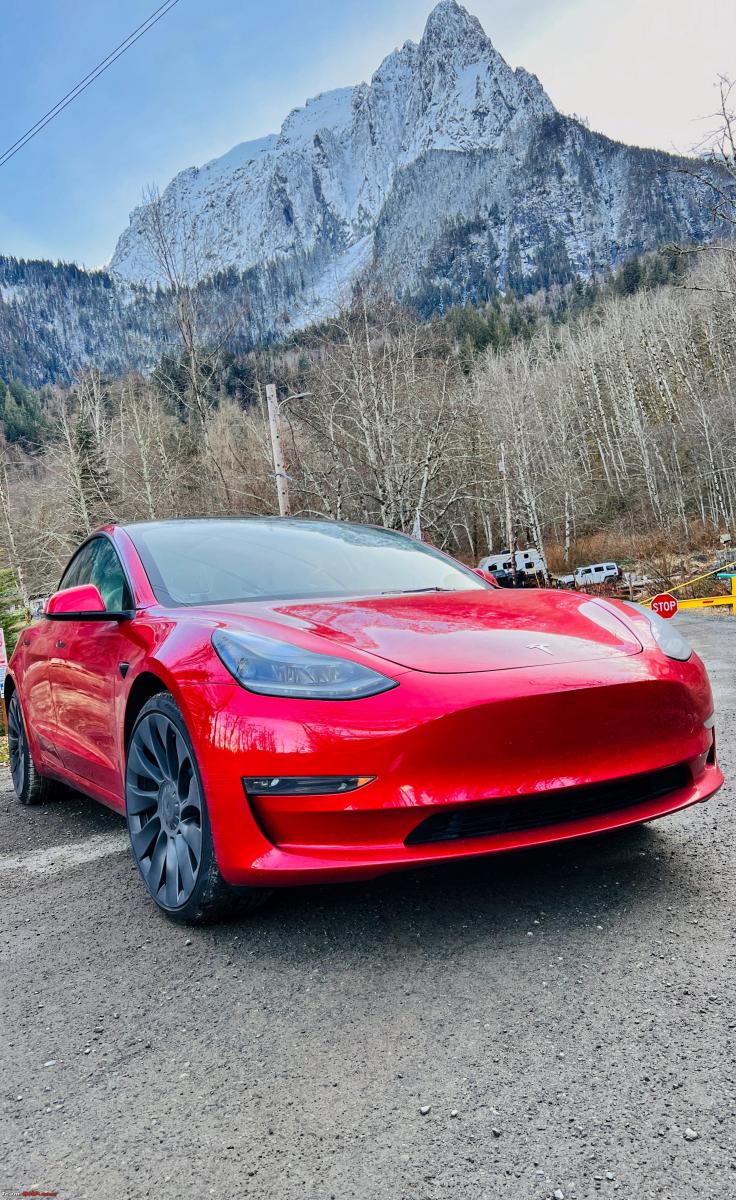
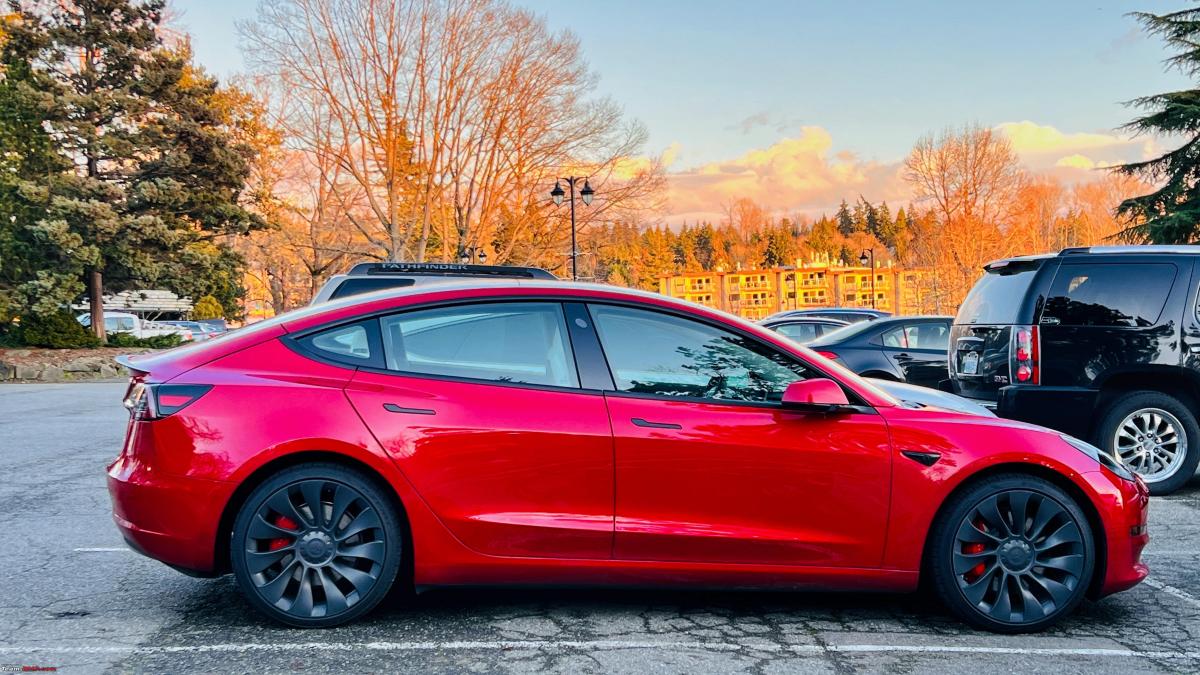
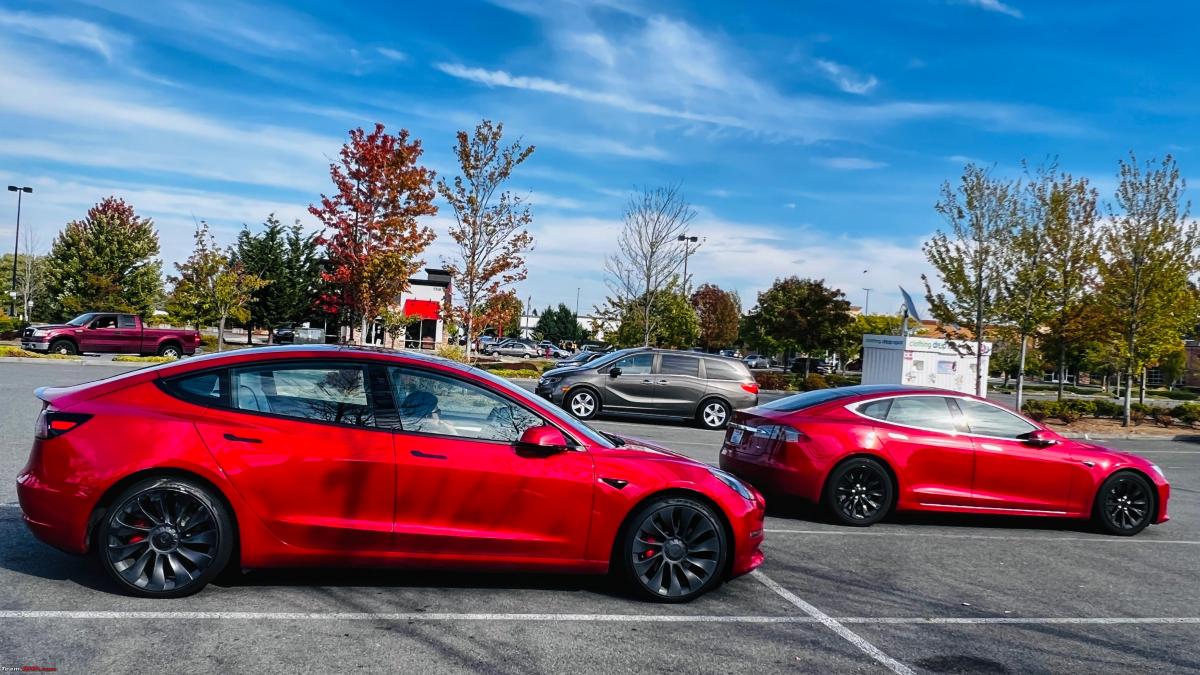
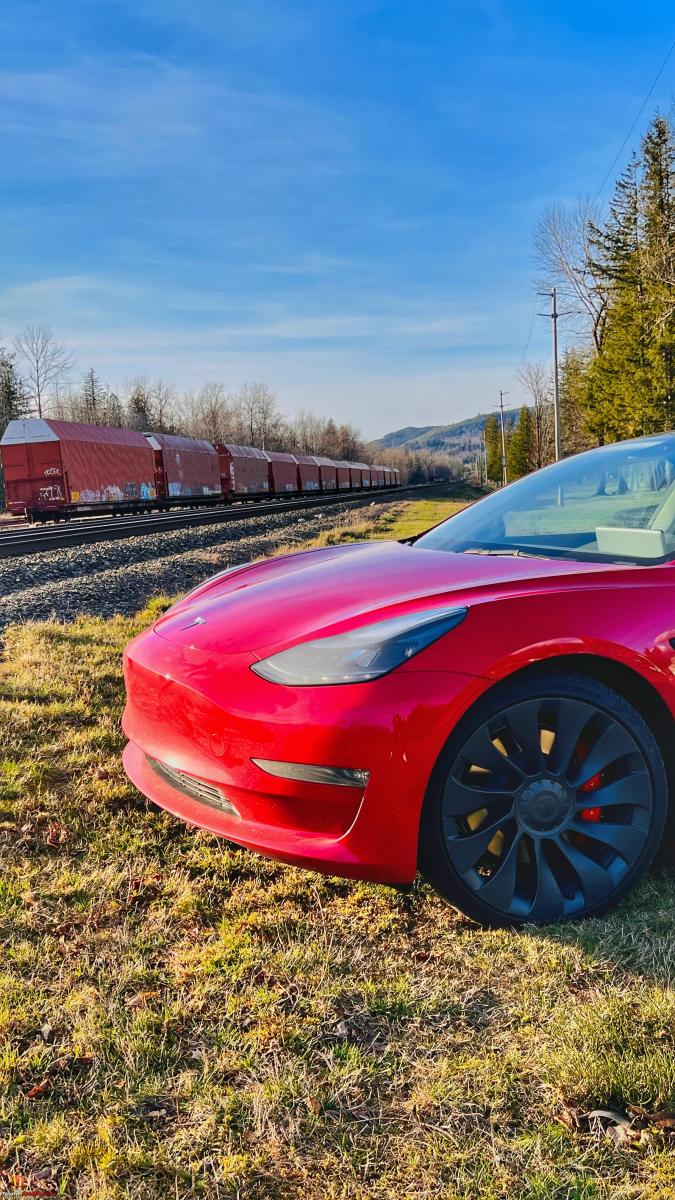
Check out BHPian comments for more insights and information.
News
Govt. approves new EV policy paving the way for Tesla to enter India
Companies will be allowed to import 8,000 EVs per year at a lower import duty of 15%.
The Government of India has approved a new EV policy that will pave the way for global brands like Tesla to enter the Indian market. A statement issued by the Ministry of Commerce and Industry states that the policy will help attract investments in the e-vehicle space from reputed global EV manufacturers.
According to the government, companies will have to invest a minimum of Rs 4,150 crore in the country. They will have 3 years to set up a local manufacturing unit for EVs with at least 25% localization.
Under the new policy, companies will be allowed to import 8,000 EVs per year at a lower import duty of 15% on cars costing $35,000 and above, which is significantly lower than the 70-100% currently levied on imported cars.
The duty waiver on EVs, which can be imported is capped at the annual PLI incentive (Rs 6,484 crore) or the investment made by the entity, whichever will be lower.
The investment commitment made by the company will have to be backed up by a bank guarantee in lieu of the custom duty forgone. The bank guarantee will be invoked in case of non-achievement of DVA and minimum investment criteria defined under the scheme guidelines.
Source: Moneycontrol
News
Driving the Tesla Model 3 Long Range with low battery in -3 deg Celcius
I told my friend that Teslas can drive for 30 miles even after reaching 0% battery so let's take a risk and drive the EV home without using a supercharger.
BHPian mobike008 recently shared this with other enthusiasts.
Experience with Tesla Model 3 Long Range: Battery & Charging
Last week, I was in New York City for some work. Post the work-related stuff, I decided to spend a day or two with some pals in New Jersey.
One of the days, we drove from Princeton, New Jersey to Soho, New York City for dinner in one of the fine-dine restaurants. We were in a friend's Tesla Model 3 Long Range which we were driving the whole day in NJ as the initial plan was to take the train to the city. But, due to getting late after meeting some friends, at the last moment we decided to take the Tesla as our reservation was for 9:00 pm and it's tough to get one.
Post dinner, we continued partying in a different location in New York City and around midnight, I got myself a lovely Gyro from the street vendor (Mandatory whenever I am in NYC). We started driving back to Princeton which was about 60 miles away. After crossing New York, my friend said let's stop at the supercharger and bump up the battery a bit before we head home.
I thought of an adventure and told him that Tesla can drive for 30 miles even after reaching 0% battery (which he was not aware of even after owning the car for 2.5 years) and told him, let's take a risk and drive home without using a supercharger. He initially agreed but, as he saw the battery % dropping (it was bloody cold, -3 Degrees Celsius), he panicked and backed off and said let's not take the risk.
I cajoled and convinced him to go the furthest and not take the first supercharger that came our way. So, we drove to Woodbridge, New Jersey and battery % dropped to 3%. We stayed exactly for 6 minutes and the battery was juiced up from 3% to 24 % and we enjoyed the drive back home in "Standard" mode. (He was driving in Chill to save up on the juice).
It was a wonderful experiment that involved all the ingredients of a thriller movie- Excitement, Fear, Panic, Anxiousness and finally the wonderful moment of Elation once the Tesla was juiced up.
Summary: After this experience, I am now not scared to drive the car until 0% battery.
Quintessential New York City Gyros--Delicious.
Battery was just going to be 3% when we reached the supercharger. It was showing, that it would be -4% battery to reach home (Princeton, NJ).
6- Minutes Supercharging Break.
Added the battery from 3% to 24% or 61 Miles (We were just 20-odd miles away from home).
Check out BHPian comments for more insights and information.
News
Tesla Model 3 software update: Multiple minor yet significant additions
I have started getting notifications on my smartphone and smartwatch to charge my EV.
BHPian mobike008 recently shared this with other enthusiasts.
I come back from a trip over the weekend and see a "candy" waiting for me.
Yup, it's none other than yet another software update from Tesla.
Some minor yet significant updates.
Reminder to plug in the car to charge. This is a good update as many folks forget to charge and they realize with a "Gosh, I forgot expression in the morning"
Already getting notifications on my phone and watch.
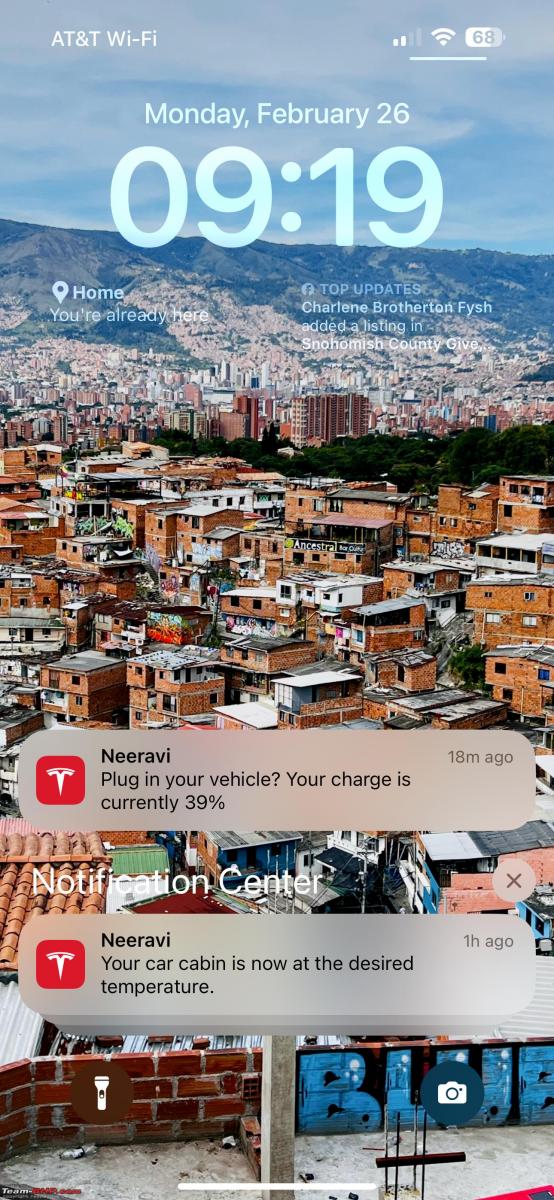
More statistics added to the battery information. Lovely!
As you may have read the news, Tesla took a lot of flak for losing range during winters. I reckon this update is to improve that situation and the battery not dropping range drastically.
Check out BHPian comments for more insights and information.
News
My Tesla Model 3 slides back even when parked in the P mode
Is it because the EV has no gears or the P function is not enough to hold the car in a slightly uphill position?
BHPian mobike008 recently shared this with other enthusiasts.
Couple of days ago a crazy incident happened.
It's snowing a bit here (not much) and roads have become dangerously icy with a lot of black sleet.
I came home and parked the car in the driveway. After an hour, I just happened to glance outside and I was shocked to see the Tesla had slid back quite a bit and almost into the community roadway.
Immediately, I parked the car inside the garage.
In the evening, I came back home and stopped in the driveway. Car was in Park (P) mode. And, with me inside, the car kept sliding back.
Is it because of no gears or P function is not enough to hold the car in a slightly uphill position?
Any Tesla owners faced this situation?
Late afternoon it was sunny and beautiful sun rays fell on mountains behind home.


Within a few hours, the weather changes to snow/hail/rain and the same roads become absolutely treacherous. That's Seattle weather for you.

I had parked close to the garage door (2 inches away- I always test the parking sensors) and look how far it slid back. Phew!
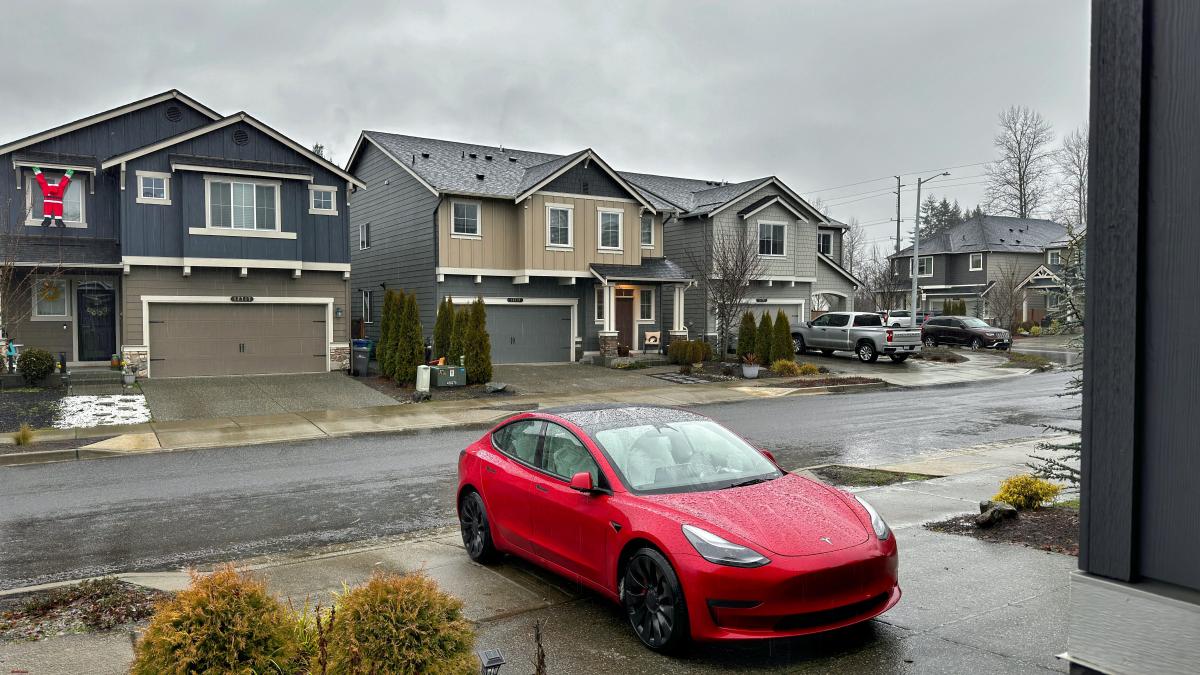
Same situation in the evening...

Here's what BHPian ex-innova-guy had to say about the matter:
Interesting that you hadn’t faced this yet. Had seen a couple of instances- 1, 2 sometime back on Reddit and had also seen a YouTube video in which the car rolled down into a parked car. Luckily yours wasn’t charging or could have been worse too. Looks like you will need to do the traditional jugaad of putting stones under the tyres.
Here's what BHPian pratik1992 had to say about the matter:
Those look like the P Zero summer tires that came with the car, right? They do warn about not using them below 45F.
Mine started sliding in turns on a cold Dec 1 in NJ. Was enough to get me to purchase a winter wheels + snow-rated tires (19s) set. Now it drives like a champ no matter what surface. I had to manually put it in drift mode to make them break traction in a parking lot when I wanted to try doing donuts. Quite fun.
Check out BHPian comments for more insights and information.
Pages




